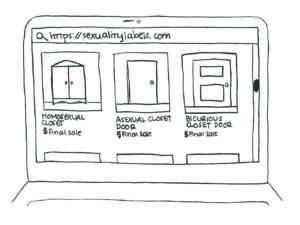
For centuries, the most common sexual orientation has been “straight.” Those who identified with a different orientation in the past often experienced harassment from others. Today, people still experience some of that same harassment. According to the Human Rights Campaign, in 2012, LGBT youth were twice as likely as their peers to report having been physically assaulted.
However, as new generations grow up with new ideals and values, people can find the courage to step away from the norm and identify with those like themselves. There are currently more Millenials that identify with the LGBT community than Generation X, Baby Boomers and Traditionalists combined, according to Gallup News. Furthermore, the creation of sexuality labels other than just “gay” or “straight,” such as “asexual,” “bicurious,” or “demisexual,” continually allows people to explore their identities and find more ways to express themselves. But despite the that labels allow, they can also induce societal pressures and stereotypes that generate conformity within those labels.
According to Entity Magazine, once someone identifies with a label, they are usually stuck with it. A label, in the case of sexual orientation, is a part of one’s identity. The moment someone chooses a label, they can possess a closed mindset that inhibits the discovery and development of their identity. A random study of 2,500 adults conducted by Springer Science & Business Media showed that on average, only three percent of the adults changed their sexual orientation over a 10 year period. What happens if someone changes their identity after they have already declared their sexual orientation? What happens when they figure out more about themselves? The freedom of expression that labels give can easily become restrictive over time.
Americans should focus less on labels as a form of expression. After NFL player Michael Sam came out as homosexual, he was repeatedly told he wasn’t “gay enough” because of his presumably masculine profession. If Sam had expressed himself by going on a date with his boyfriend instead of explicitly stating his identity, he likely would have experienced a reduction of societal pressure and a separation of private life from from his career. However, even though he was in the process of trying to be his own person, others in society still decided had the opinion that he did not fit the stereotypical description of a homosexual and therefore shouldn’t identify as one. The labels people take on can produce a positive effect with the discovery of identity, but can also bring a negative effect with pressures and stereotypes. These pressures can only be eliminated by the individual’s form of expression, not society’s reaction to the expression.
According to research by Dr. Savin Williams at Cornell University, more people identify as “mostly straight” than those who identify as gay and bisexual combined. Even within the “mostly straight” category, people exist on a wide spectrum, from experimentation to actual attraction. “Some only have sexual or romantic attraction for their less preferred sex, others experience a small degree of both same-sex desire and romantic infatuations, and some are willing to sexually experiment if the right woman or man comes along,” said Dr. Williams to academicminute.org.
Netflix introduced the first season of Bill Nye’s TV show, Bill Nye Saves the World, in April of 2017. As Nye states on his episode The Sexual Spectrum, “There are lots of flavors to sexuality.” He adds, “We’ve got to listen to the science. And science says we’re all on a spectrum.”
So what if we didn’t have these labels in the first place? If labels didn’t exist, their stereotypes would not exist either. People could just identify with how they actually feel instead having to make up a label or choose between those that already exist. Listen to the science. Our society should have the least amount of focus on labels, and the most focus on exploring and defining sexual orientation through present experiences.






